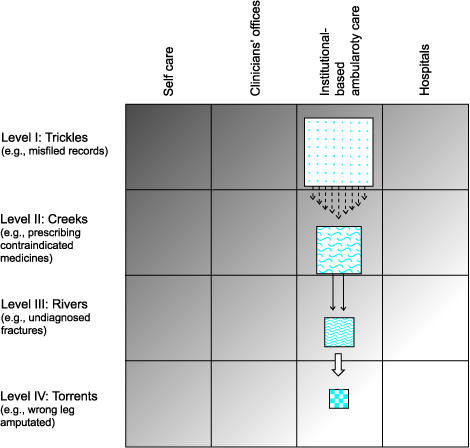
Am Fam Physician. 2001;63(6):1047
The Patient Safety Grid shows the fields where action is necessary in a comprehensive national effort to reduce harm from medical errors. Each segment of the grid is important and connected to others, sometimes forming a toxic cascade.
To date, inadequate conceptualization of the scope of medical errors has led to an unbalanced approach to tackling the important public health problem of medical errors. Hospital sites of medical errors are overemphasized, while the bulk of the health care enterprise is neglected. Patients are the key. It is likely that the number of opportunities to reduce medical errors in different parts of the health system is proportional to the number of patient contacts made there. The Patient Safety Grid represents toxic cascades of medical errors (levels I to IV, Trickles to Torrents)1 in different health care locations and settings. The light shading shows where we know most about threats to patient safety, and the dark shading shows where there is most left to find out.

We know most about least. When patients die as a result of medical errors (level IV), we have systems already in place to investigate and repair problems, but most medical errors do not cause death as an immediate consequence.
We know least about most. We know that most health care delivery happens in ambulatory settings and we propose that most errors are Trickles with no immediate harm to patients. We do not know how frequently level I and II errors happen in primary care settings, in office-based subspecialty settings or in hospital settings, nor what happens afterwards.
Errors and their causes exist in every box on the grid and at the interface between boxes. This model offers a flexible way to think about medical errors that can locate efforts by individual groups, agencies and professions within a system-wide approach. An adequate strategy to detect, report and correct mistakes will incorporate all of these settings and their toxic cascades.